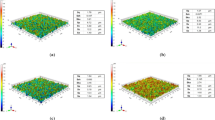Surface roughness plays an important role in product quality. This paper focuses on developing an empirical model for the prediction of surface roughness in finish turning. The model considers the following working parameters: workpiece hardness (material); feed; cutting tool point angle; depth of cut; spindle speed; and cutting time. One of the most important data mining techniques, nonlinear regression analysis with logarithmic data transformation, is applied in developing the empirical model. The values of surface roughness predicted by this model are then verified with extra experiments and compared with those from some of the representative models in the literature. Metal cutting experiments and statistical tests demonstrate that the model developed in this work produces smaller errors than those from some of the existing models and have a satisfactory goodness in both model construction and verification. Finally, further research directions are presented.
Similar content being viewed by others
Author information
Authors and Affiliations
Rights and permissions
About this article
Cite this article
Wang, X., Feng, C. Development of Empirical Models for Surface Roughness Prediction in Finish Turning . Int J Adv Manuf Technol 20, 348–356 (2002). https://doi.org/10.1007/s001700200162
Issue Date:
DOI: https://doi.org/10.1007/s001700200162




